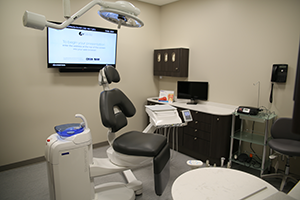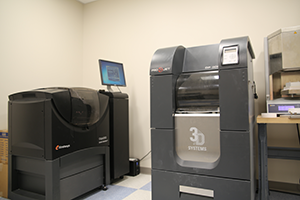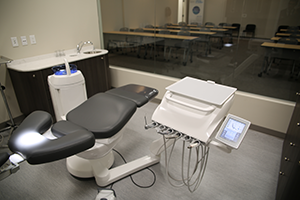
Integration is a growing trend in dentistry, with many offices expanding to include multiple specialties. But integratedDENTAL in Woodbury, NY, takes full service even further by incorporating a laboratory and an educational facility in addition to its practice, all connected via the latest digital technologies.
“The genesis was basically to be able to demonstrate the entire digital workflow from both the clinical and the laboratory aspects,” said Alan Jurim, DDS, one of the 3 dentists at the practice. “When doctors are able to see both ends of the spectrum and better understand the steps involved, they can produce a more consistent, predictable result.”
The Practice
Dr. Alan Jurim is a general dentist certified in sedation dentistry, focusing on restorative, implant, and aesthetic cases. Barbara Jurim, DDS, is a prosthodontist specializing in restorative, implant, and cosmetic cases. Brandon Katz, DDS, is both a prosthodontist and a periodontist who also is working on his certification in sedation dentistry.
“We really have the ability here to tackle almost anything that dentistry throws at us because of this team,” said Adam Richichi, chief operating officer of integratedDENTAL. “And we’re growing the team right now. We’re bringing in some more general dentists, some more specialty care.”
“Essentially, we wanted to be able to provide every service imaginable for patients under one roof. So it really is very nice to be able to tell patients you need to have x, y, and z, and you don’t have to go to multiple offices,” said Dr. Barbara Jurim. “We can do it all here, and they appreciate that.”
The facility includes multiple operatories in addition to a pair of surgical suites for larger cases, with 4 more operatories now being outfitted. The practice also is building a room dedicated to intraoral scanning. Plus, a photo studio supports cosmetic cases and enables before-and-after photography.
 |
|
Figure 1: The surgical suites use motorized Planmeca Sovereign chairs that help patients who need assistance to sit down, recline, and get up again naturally. Flat-screen monitors in each operatory also allow the practitioners to play multimedia, show live video during procedures, and more. |
 |
|
Figure 2: The lab uses a pair of 3-D printers to create accurate restorations and other appliances, improving efficiency. |
 |
|
Figure 3: One of the facility’s treatment rooms features a glass wall fronting a 32-seat conference room so dentists and other professionals can watch live procedures. Video cameras in the treatment room and flatscreen monitors in the conference room provide closeup views of the action. |
Each station is equipped with top-of-the-line gear, too. The surgical suites, for instance, use motorized Planmeca Sovereign chairs that help patients who need assistance to sit down, recline, and get up again naturally (Figure 1). Flat-screen monitors in each operatory also allow the practitioners to play multimedia, show live video during procedures, and more.
“We can take patients on a tour around their own mouth,” Richichi said.
“The very technology that we use to capture the data to treat the patients in and of itself is an interesting marketing tool, because they get to see and feel their own dentistry and they see the technology, and it is impressive,” said Dr. Alan Jurim. “There’s nothing shallow about it. It is very useful, and it leads to better outcomes.”
In fact, the practitioners can access the practice’s audio-video system and other networks right from their smartphones. Dr. Alan Jurim—who holds dual undergraduate degrees in computer systems engineering and electrical engineering—designed, programmed, and installed the network himself. With this experience, he also takes the lead in shaping the practice’s use of cutting-edge technology.
“That same background allows him to be very much involved in the development of the technologies on the engineering side,” said Dr. Barbara Jurim. “He has beta tested many products for different companies to make sure from a clinical standpoint that their technologies make sense.”
“Technology is important in the workflow. Its main role is to try to simplify the workflow,” Dr. Alan Jurim said. “So if the workflow used to involve 30 steps, we hope that we can adapt that technology to bring it down and make the process simpler and ultimately more productive.”
In particular, the practice relies on intraoral scanning, 3-D x-rays, and digital photography.
“Combine those tools all together and you’ve opened a new world of possibilities of what a dentist can perform compared to old analog tools,” he said. “So I always like to say it adds to their digital dental toolbox. When you have these tools, you can now increase the efficiency.”
For example, the practitioners at integratedDental favor the TRIOS intraoral scanner from 3Shape.
“We do a lot of full-mouth rehabilitations, and taking a full-arch impression was very stressful upon me, upon my assistant, and upon the patient, because if I didn’t capture everything in the first shot, it would be another 40 minutes trying to get everything set up for a second shot,” said Dr. Barbara Jurim.
“With the TRIOS, I have the ability to cut all the little areas out, stitch the little areas back in, and have that permanent record that is not going to distort at all,” she said. “So if in the event I have to go back to that, I can always get the same exact result over and over. It’s really nice.”
“The TRIOS scanner has been revolutionary. I have experience using many different scanning systems, and TRIOS and the technology brought to us by 3Shape ultimately provides us with the most powerful, simplified process,” said Dr. Alan Jurim.
These tools generate lots of digital data, and integratedDENTAL uses Dentrix Ascend from Henry Schein to process it all. The cloud-based software integrates imaging, treatment planning, and other patient records along with practice management functions, including insurance, finances, scheduling, and more. This digital record-keeping is key, too.
“Nothing will distort. I can always revert back to that record and it really captures the patient at a specific point of time, and I can monitor that patient over time to see any changes,” said Dr. Barbara Jurim. “If anything should happen, I know where they once were where they were comfortable. That kind of digital patient monitoring is really exciting.”
The Laboratory
The facility also includes a full analog and digital laboratory on site. There’s family history, too. In 1996, Alan and Barbara Jurim’s father Adrian Jurim, MDT, founded the Jurim Dental Studio, specializing in comprehensive cosmetic dentistry and implant restorative solutions. Like his son, Adrian is an innovator, holding the patent for etched porcelain laminate veneers.
“In the early 1980s, my mom fractured one of her front teeth. Unfortunately prior to that, the only fix was unaesthetic bonding. And he felt that, ‘That is not the way I want to restore my wife’s tooth. I don’t want to look at that smile every day,’” said Dr. Barbara Jurim. “So he thought long and hard, and he came up with the technique.”
Things have changed in the approximately 30 years since that procedure. These days, integratedDENTAL’s technicians take the scans acquired in the operatory and use CAD/CAM systems to design restorations and implants all on the computer screen. Having these technicians down the hall from the operatory also is a big advantage.
“Last week I was doing a single-unit front tooth. That’s something that tends to be the most taxing kind of procedure in dentistry because it’s very hard to match one tooth to everything else. So that procedure traditionally involves many trips by the patient back and forth between the dental office and the dental lab,” said Dr. Barbara Jurim.
“But the fact that we were both housed under one roof allowed for that whole treatment process to be streamlined because the technician was physically able to come over, to meet and take a look at the patient, and to get the information they need to finish that case right then and there,” she said.
The lab still has a plaster room and a sintering room, which is equipped with a brand-new burner. But instead of crafting restorations, implants, and other devices by hand, the technicians may send their digital files to one of the lab’s 3-D printers, significantly improving efficiency—and allowing the techs to leave work on time at the end of the day (Figure 2).
“It’s completely automated,” said Brian Connors, one of the technicians at integratedDENTAL. “So you spend 5 minutes here on the computer, and you tell it to go to the printer. You come in the next morning, and it’s done. And that’s great. That’s much better than doing it in stone where you actually have to be there for it and get the dyes by hand.”
Looking ahead, integratedDENTAL plans on expanding its milling capacity into some of the vacant space currently on site with an eye on mass production functionality.
“Right now we have some milling machines that aren’t used very much—I wouldn’t say sporadically, but need-based—whereas milling machines that are plugged into ordering systems that are coming from all over the world can be working around the clock here,” said Richichi. “That’s our future, and we’re working with some partners for that.”
The Educational Facility
The members of the staff at integratedDENTAL aren’t interested in keeping this digital dentistry to themselves. The facility also was designed with education in mind, where the practitioners and their partners could offer live demonstrations, seminars, and workshops on the latest techniques and technologies.
For example, integratedDental recently hosted the faculty of the Touro College of Dental Medicine, opening this fall in Manchester, NY. Dr. Alan Jurim showed these teachers how to use the TRIOS, and he says that their relationship is just getting started since many schools are a little behind when it comes to new technology, and they want to catch up.
“New dentists are coming out of school wanting new technology,” said Richichi. “These technologies are changing so fast, and we’re very much on the inside scope. We work with 3Shape and other technology partners. We’re seeing these things firsthand, which is why we see a big opportunity to be part of that education process.”
There’s a treatment room on site with a glass wall fronting a 32-seat conference room so dentists and other professionals can watch live procedures (Figure 3). Video cameras inside the treatment room and flat-screen monitors in the conference room give members of the audience a better view of the procedure as well as other digital data. Plus, visiting dentists can check out the rest of integratedDENTAL’s gear and workflow.
“The whole point of this building and how it was designed was to capture the attention of visitors and keep them interested in digital dentistry,” said Richichi. “As they’re walking down to a lecture, they get to pass by the milling machines and 3-D printers and see technicians working there. And they get to see the technology in action. They get excited about it as they go to learn about it.”
“Everything that we have gained—all the knowledge that we have gained in digital dentistry from having the clinical and laboratory aspects under one roof—our goal is to be able to be a resource and share that with our colleagues,” said Dr. Alan Jurim. “Not to be the competition, but to be a resource for them. We can say, ‘This is how we were able to do it. This is how we can help you adapt it.’”
Clinicians don’t have to come to integratedDENTAL to benefit from its educational offerings, though. The facility is wired to broadcast its sessions on the Web. Dr. Alan Jurim, who leads the educational efforts, also is available to share files and conduct live chats online. Plus, the jurimdentalacademy.com website soon will host discussion boards, videos, and other educational resources.
A Beneficial Partnership
The facility brings together the previous practice, the Jurim Dental Group, with the Jurim Dental Studio and its CADpro Dental milling center, as well as the new Jurim Dental Academy. These facets of the family business all had been working with Henry Schein in various capacities, though, when the integratedDental concept was born about 3 years ago.
“They have been a dental client of ours for a very long time. We actually provided consulting services to help them grow their practice from their past facility—a small, 1,200-square-foot facility—to this larger facility so they were prepared to move into this larger area,” said Victor Andrade, regional manager with Henry Schein.
“Our mission at Henry Schein is to focus on practice care so that our customers can focus on patient care,” said Jake Meadows, vice president of sales for the eastern area at Henry Schein. “Any opportunities we have to partner with integratedDENTAL to make the clinicians better helps us achieve our mission with practice care.”
Henry Schein provided consulting services in building integratedDENTAL in addition to conducting practice analysis and securing banking and financing partners. The company also was able to provide resources in dealing with equipment suppliers such as A-dec and Planmeca, ensuring the right technology was in place as integratedDENTAL took shape—and will keep taking shape.
“This is where our digital sales specialists and equipment technology specialists worked very closely with the contractors as they laid out the infrastructure in the building,” said Meadows. “They really do build in pathways for other technologies to be integrated in the future. There’s a lot of partnership that happens.”
“There isn’t a technology in this office that isn’t built to be completely revamped and redone in 5 years as technology develops,” said Ryan Steck, director of equipment and technology sales, eastern area, with Henry Schein. “Everything, including the 2 surgical suites we put in there, are cutting edge today, but they’ll be cutting edge in 5 years too because of their ability to adapt and grow with new technologies.”
Ultimately, though, the technology is there to help the practitioners at integratedDental and their colleagues elsewhere provide better care.
“Digital dentistry is not about intraoral scanning. It’s not about being able to buy tools that aren’t useful,” said Dr. Alan Jurim. “It’s really about the patient experience. Our goal is to be able to incorporate as much of the digital dentistry and new tools available to consistently improve that experience.”
Related Articles
Collaborative Dental Practice Targets Systemic Healthcare
New Dental School to Open in New York This Fall
Desktop 3-D Printing Democratizes Implant Dentistry











